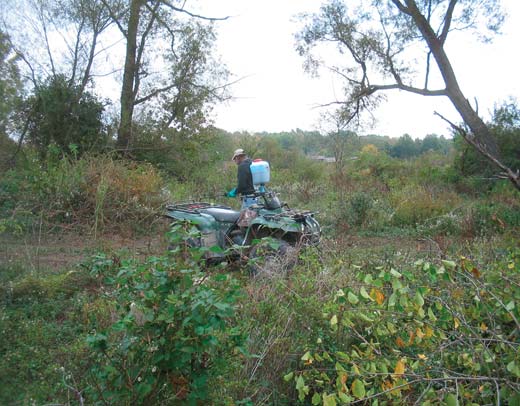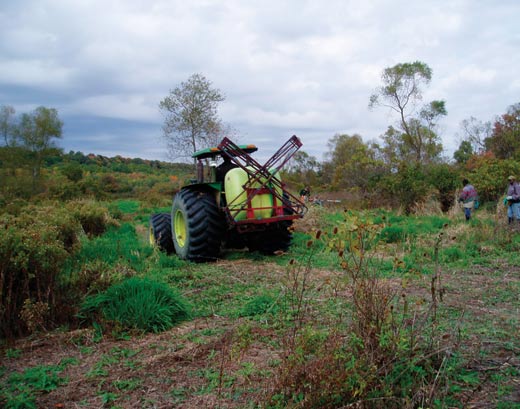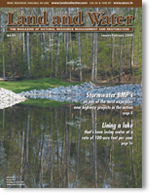Features Available Online
The Pond Brook Wetlands Mitigation Project

A Davey contractor treats glossy buckthorn using a cut stump method.
The Project
A 164-acre tract of wetlands in Northeastern Ohio, which had been channeled and drained for farm use more than a century ago, is being restored to its pre-agricultural state in a multi-year project that involves governmental units and private entities. Restoration steps include eradication of invasive species, re-establishment of native plants, removal of drainage ditches and the return of a stream to its natural flow.
The parcel is one section of the 1,500-acre Liberty Park, which is managed by Metro Parks, Serving Summit County. Metro Parks is a multi-facility system, which took over management of the land from the City of Twinsburg after the city purchased it from a private owner.
The zone within the park being restored is known as the Pond Brook Wetlands Mitigation area. A mitigation banker, Wetlands Resource Center, contracted with Metro Parks to restore the Pond Brook area knowing that the region’s development would result in a demand for wetland restoration to match wetland destruction. The Center put together a team that included the Davey Resource Group (DRG), Oxbow River and Stream Restoration and EMH&T for the restoration work. The project took on additional significance when the Ohio Department of Transportation (ODOT) agreed to fund a large portion of the work to meet mitigation mandates arising from a highway improvement project it is planning nearby.
A confluence of interests is pushing the project forward: a single mitigation location in the same watershed efficiently satisfies state and federal mandates that ODOT must meet for its highway project; ODOT funding supports Metro Parks’ stewardship at Liberty Park; and the residents of Summit County will enjoy better water quality and enhanced open space.
The first phase of the project is invasive plant removal, which DRG began in 2004. Using backpack units, ATV-mounted tanks, mowers, chainsaws and helicopter spraying techniques, DRG is clearing 50 acres of invasive species. Once the competition of invasives is reduced, native species will re-emerge as seeds now dormant in the soil germinate. Mitigation standards require that at the end of a ten-year period the invasive species be reduced to represent less than 10 percent of the plant material in the tract. To ensure that end, DRG will monitor invasive plant coverage in the tract and recommend control. EMH&T will provide engineering support for the current phase of the restoration.
In a later stage, Oxbow will restore Pond Brook’s meander through the wetlands and will develop the drawings and conduct the permitting for that project.
The goal is to complete the invasive plant eradication and native plant re-establishment before the stream bed is reconfigured. That is a logistic necessity because access to the area on foot or by ATV will be much more difficult - if not impossible - after the channels directing water flow are disrupted.
The Background
As commercial and residential development encroached on the dwindling open space in northeastern Ohio, residents of the City of Twinsburg, voted to purchase a 900-acre tract to be maintained as open space.
Because of the size of the parcel, Twinsburg turned to Metro Parks, Serving Summit County to help manage the purchased property. Metro Parks created Liberty Park from the Twinsburg land and another tract in the adjacent Village of Reminderville. Twinsburg will develop and maintain the athletic fields in Liberty Park and Metroparks will manage wildlife and maintain bike and hike trails.
In addition to the wetlands that are being restored, the Park includes ledges that contain a hibernaculum used by at least three of the eight species of bats that have been identified in the park. One of those species is the endangered Indiana bat. Also within the park are a forested area, open areas that include recreation fields and hiking trails. The range is from crowd-friendly softball diamonds to limited access marshes.
The Park provides valuable open space in a community that is rapidly growing. The same development that spurred Twinsburg to purchase the former farmland, has also been testing the capacity of highways in the region.
One artery, State Route 8, was targeted by the Ohio Department of Transportation (ODOT) for expansion. The segment runs through the cities of Hudson and Macedonia and Village of Boston Heights and through natural wetlands. Because the planned construction will disrupt the streams and wetlands within the project footprint, ODOT must meet the minimum ratio of 1:1 acres lost:replaced required by Ohio EPA and the Army Corps of Engineers. The Ohio EPA and Corps also require restoration of a specified number of linear feet of stream. The 164-acre Pond Brook Conservation area within Liberty Park meets those requirements. The funding available from ODOT for the restoration is supporting the Ohio EPA and USACE mandate that there should be no net loss of wetlands in the watershed and that water quality standards be met.

Davey workers access different areas of the wetlands targeted for spraying using a MLS tractor.
Project Implementation
The goal of the collaborative project is to take the Pond Brook wetlands back to pre-agricultural conditions. That goal poses a challenge because there is no clear record of the stream’s original path. Clearly, the stream’s bed was dredged and ditches were dug to drain the area to make more land available for farming. In 2001, when the Twinsburg voters approved a tax to support the purchase of the area, the property had not been farmed for 50 years, but the ditches constructed to accommodate agricultural uses had heavily silted and become overrun with invasive plants. The mitigation project will be successful if it restores the wetland functions and creates healthy stream channels.
To that end, part of the mitigation effort includes control of the invasive plant species that have been introduced into the wetlands through agriculture. The second part is the re-introduction of native plants. The rapid expansion of the invasive species pushed out native ones, changing the nature of the landscape. The conservation area has been designated a low impact area, which means that mowing will be done only once per year along the restricted access trail and no improvements will be made in the area. That step helps ensure that native species being re-introduced will not be disturbed once again by human activity.
Beginning in 2004, DRG began the multi-year effort to eradicate invasive and re-introduce native species to the wetlands. Decade-long monitoring will assure that the benchmark of maintaining the invasive species at less than ten percent is met.
Among the species that are targeted for eradication in the 50 acres of wetlands adjacent to Pond Brook within Liberty Park are Phalaris arundinacea (canary grass), Phragmites australis (common reed), Rhamnus frangula (glossy buckthorn), Typha angustifolia and T. x glauca (hybrid and narrow-leaved cattails). DRG is treating nearly 39 acres of cattails. Grasses cover about a half an acre, while the glossy buckthorn covers approximately 10 acres scattered throughout the site. DRG biologist and commercial pesticide applicator, David Riddell, is field manager for the project under the direction of Michelle Malcosky, biologist and coordinator of DRG ecological services. Senior biologist, Ken Christensen, and intern, Eric Countryman, as well as contract workers also have been involved in the labor intensive effort.
The invasive species are being treated with Rodeo®, which contains glyphosate, a chemical that interferes with successful photosynthesis in plants. The formulation being used at Pond Brook is aquatic approved. Rugged off-road utility vehicles equipped with 25-gallon spray tanks and 10-foot boom sprayers carry the applicators into the marshland. Because rare plants occur within the Park in the more sensitive non-monoculture areas, applicators use backpacks for low-volume foliar spraying. Woody species receive cut stump treatments of the chemical. In areas where large monocultures of invasive species exist, spraying from helicopter has been conducted once per season.
Because timing of the glyphosate application is critical, much of the project is weather dependent, and because of annual flooding, which will re-introduce invasive plant seeds to the area, treatment will be ongoing for several years. Continual vigilance against buckthorn will also be necessary as birds attracted to the berries spread the nuisance.
To bring the area back to its pre-agricultural state, DRG will nurture native species and care is being taken to protect mature stands of Cephalanthus occidentalis (buttonbush) from the eradication operations. As the cattails die, they are being mowed so that next season’s emerging cattails will be exposed to the herbicide application.
The invasive species eradication effort is estimated to cost $100,000 over ten years, although the nature of the work means that over time fewer plants will need to be treated.
Challenges
In addition to the challenges presented by the persistence of the invasive plants in the parcel, the existence of nearby residential development and the need to coordinate the efforts of many partners have added to the complexity of the project.
Neighbors of the area expressed concern about the traffic generated by the invasive species eradication workers and potential damage their passage might do to infrastructure. Those issues are forcing the crew to find other points of access to the worksite.
A package treatment facility to the north of the wetland has also been a point of contention. The best science would direct the treated water to be allowed to flow through the wetlands, which would provide support for the marsh conditions and further improve the water quality. Misinformation, including threats of disease, has denied that water flow to the area.
Next Phase
As the active phase of invasive species eradication becomes effective, the work to restore the hydrology to the wetlands and restore stream channels will get underway. The monitoring phase will start when the work on the Pond Brook channel restoration begins. Before then, a contract to re-introduce native plants will be let. That step will be helped by nature: some native plants will re-emerge as competition from fast-spreading non-natives is removed and desired plant colonies from nearby areas will spread as conditions for their survival improve.
As invasive plant populations are reduced, native vegetation will be encouraged and the channels and ditches that drain and move the water rapidly through the area are restored to a more natural state, project managers will be able to judge the success of their effort. ![]()
For additional information, contact David Riddell at The Davey Tree Expert Company, 800/828-8312 or at driddell@davey.com. For more information about Davey, browse at www.davey.com

